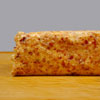Blend all ingredients in a food processor. Add olive oil a little at a time at the end. You want the pesto to be blended yet not smooth. It is best with a little texture. Serve at room temperature. Do not heat it. Serve over salmon or your favourite fish. Serve tossed with some basmati rice.



